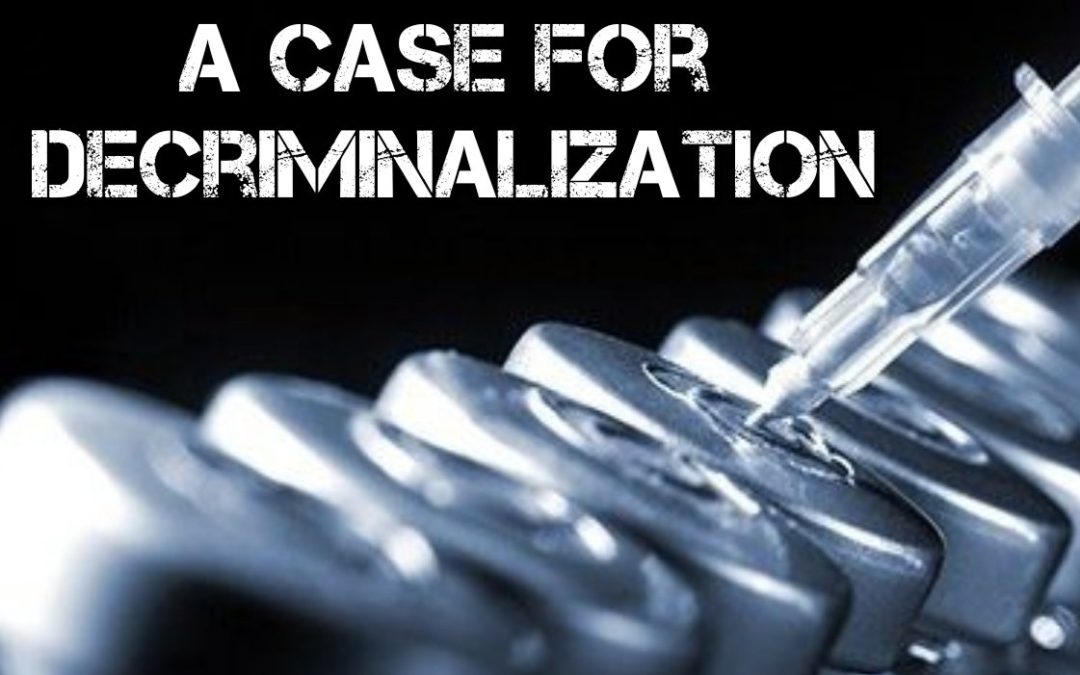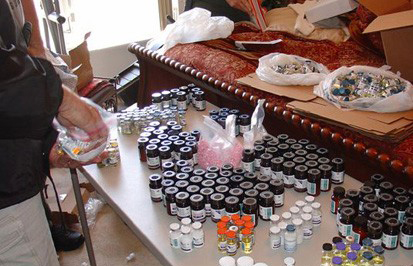This article is one of a series of Articles I plan on posting related to Anabolic Steroids. I hold the belief that Anabolic Steroids should be decriminalized. The primary reason (among many) I think steroids should be decriminalized is because the way in which Anabolic Steroids were made a controlled substance in the first place was complete and absolute bullshit and frankly, it was a classic example of government overreach. In this article, I’m only going to focus on the details surrounding the passing of the law.
THE BEGINNING OF THE END FOR ANABOLIC STEROIDS
During the mid-eighties, anabolic steroids were classified as prescription medicines, and were required to be prescribed and dispensed by licensed physicians. Their federal regulation came under the jurisdiction of the Food and Drug Administration under the Food, Drug and Cosmetic Act. However, in time, after much banning and warnings against their use by the athletic communities, the press began reporting widespread public usage along with mass hysteria as to the negative side effects associated with them, most of which were extremely exaggerated if not completely fabricated.
Members of subcommittees in both the House and Senate drafted bills and scheduled hearings to address the issue. In 1987, a House bill was introduced making it a felony to distribute steroids without a valid prescription. The next year Ben Johnson tested positive for Stanozolol (winstrol) at the 1988 Olympics in Seoul, South Korea, and was stripped of his gold medal.
The subsequent outrage got the attention of Senator Joe Biden (Yep, that Joe Biden) and he introduced a similar Senate bill. President Reagan signed the resulting legislation as part of the Anti-Drug Abuse Act of 1988. The new law punished traffickers of anabolic steroids for non-medical reasons with up to three years in prison (up to six years if sold to minors under 18 years).
Subsequently, a new bill was proposed to create the “Anabolic Steroid Restriction Act of 1989” which would criminalize using the mail to transport or sell steroids. One important note is the law permitted the persecution of dealers and distributors WITHOUT authorizing the arrest or prosecution of personal users, and the law did not classify anabolic steroids as a controlled substance. (1)W.N. Taylor, M.D., “Synthetic Anabolic-Androgenic Steroids: A Plea for Controlled Substance Status,” The Physician and Sportsmedicine (Vol. 15, Number 5, May 1987
Since the new bills and laws imposed no federal controls on the manufacture and prescription of anabolics, they didn’t prevent steroid products from being diverted to the black market. More or less, there was speculation that perhaps steroids were purposely being overproduced and a certain amount of the overproduction was being diverted to illegal trafficking (Although there were 175 different trafficking prosecutions (2)Rorie Sherman, “The Big Push,” Nat’l L.J., Feb. 10, 1992, at 40, 42 as well as 125 different steroid related prosecutions in 27 different federal districts (3)J.E. Wright and V.S. Cowart, Anabolic Steroids: Altered States (Carmel, IN; Benchmark Press, 1990), at 118. after the law was passed.) For this reason, a few doctors began suggesting controlled substance status for anabolic steroids, and for some reason, got the attention of Congress, and they set out to list them as a controlled drug.
“However, after much banning and warnings against their use by the athletic communities, the press began reporting the widespread public usage along with mass hysteria as to the negative side effects associated with them, much of which were extremely exaggerated if not completely fabricated”
ANABOLIC STEROIDS: EVALUATION AS A CONTROLLED SUBSTANCE
The process by which drugs are to be added to the controlled substances schedules falls under the authority of the Attorney General. The Department of Health and Human Services (DHHS) has a list of what a substance must have in order to qualify to be scheduled and therefore be considered dangerous. Controlled substances are pretty much substances that the government and authoritative agencies within the government believe, based on evidence, have a significant potential for abuse, and pose a danger to the public as such. The list is as follows:
- Its actual or relative potential for abuse.
- Scientific evidence of its pharmacological effect, if known.
- The state of current scientific knowledge regarding the drug.
- Its history or current pattern of abuse.
- The scope, duration, and significance of abuse.
- What, if any, risk there is to the public health.
- Its psychic or physiological dependence liability.
- Whether the substance is an immediate precursor of a substance already controlled under this title.
After evaluating these eight factors, the Secretary of the DHHS makes a scheduling recommendation based on the substance’s relative potential for abuse, its accepted medical use, and its potential for producing physical and psychological dependence. Before proceeding to control a drug under this process, the Attorney General also must request from the Secretary of the DHHS a scientific and medical evaluation of the drug and make a recommendation as to whether the drug should be controlled and scheduled. In the case of steroids, Attorney General Edwin Reese requested this process be done in 1987. In October of 1987, after review, John Lawn, Administrator of the DEA, concluded that anabolic steroids should not be made controlled substances. The following year in March of 1988, Health and Human Services Secretary Otis Bowen agreed. Neither agency viewed anabolic steroids as meeting the criteria for a controlled substance.
So at this point, the new law had criminalized steroid trafficking and the appropriate agencies had concluded that scheduling anabolics was inappropriate. The issue would seem to have been resolved. But members of Congress, it would be seen, had other ideas.
In July of 1988, the Subcommittee on Crime of the House Committee on the Judiciary convened to consider a bill to amend the Controlled Substances Act to add methandrostenolone (dianabol) as a Schedule I controlled substance. (Which proves how stupid congress was at that time because of all the steroids they could have chosen, they chose Dianabol, which had been discontinued in 1983 and was pretty much removed entirely from the market by 1986.)
ANABOLIC STEROID ACT OF 1990
Public health, medical and scientific experts overwhelmingly advised against the scheduling of steroids. The American Medical Association (AMA), the Food and Drug Administration (FDA), the Drug Enforcement Administration (DEA), the Department of Health and Human Services (HHS) and the National Institute on Drug Abuse (NIDA) all unequivocally opposed legislation that scheduled steroids.
Gene R. Haislip, the Deputy Assistant Administrator for the DEA, argued that the Controlled Substances Act (CSA) was “poorly suited” to regulate anabolic steroids. The CSA was never “intended to be a means for controlling substances that are taken primarily for their effects on the physique rather than for their effects on the mind.” He went on to say, “The Controlled Substances Act is built entirely and exclusively around drugs which are principally psychoactive and are abused almost exclusively by virtue and because of that property. All of these drugs can be described either as narcotics, stimulants, depressants or hallucinogens.” The DEA position, he made clear, was to continue its opposition to scheduling steroids, stating that the DEA was not “the appropriate body to enforce any measures of this kind.”
Charles Yesalis, Sc.D., professor of health and human development at Penn State University and probably the world’s foremost expert on steroids, repeatedly stressed to the subcommittee that the medical side effects were mostly temporary, and presented a balanced and objective assessment:
“Steroids do have a medical use. From an epidemiological point of view of the health dangers, I am much more concerned about heroin; I am much more concerned about cocaine; I am much more concerned about cigarettes than anabolic steroids. This is not to say steroids are not potentially dangerous rather, from what we know currently, I am more concerned about the other drugs – and you could likely add the abuse of alcohol to that list – than anabolic steroids.”
Regarding the issue of steroids’ addictive potential, Dr. David Bever, an associate professor of health education at George Mason University who had recently conducted a study about steroid usage among bodybuilders and power lifters in the D.C. area, said: “We did not find that it was habituating…” and also “The guys – when they went off, they went off with few or no problems at all.”
The AMA repeatedly and vehemently proffered recommendations against such legislative action. The AMA was adamant that the “medical facts did not support scheduling anabolic steroids under the CSA.”
In April of the following year, Dr. Edward Langston, a representative of the AMA, testified that anabolic steroids had multiple legitimate uses in medicine, they could be used safely under medical supervision and they did not meet the physical or psychological dependence criteria required for scheduling under the CSA. Furthermore, scheduling steroids would not reduce the use of steroids and society and would only increase the harms associated with black market steroids. This prediction by Dr. Edward Langston has proven to have been correct as the black market for steroids has only grown since the passage of the bill. Congress created the very situation they were supposedly trying to prevent.
Dr. Yesalis once again gave an objective review, and explicitly recommended against scare tactics, saying, ” increased death, probability of death or morbidity could be taking place, but people apparently are not dropping like flies. And I think we have to be careful not to lose further credibility.”
Congress was undeterred by the inconvenient medical and scientific facts standing between the passage. It was determined to add steroids to the CSA regardless of what health, medical and scientific experts had to say. (The experts were actually mocked and reportedly interrogated by Joe Biden as Biden was walked around throwing insults to them and forcing them to defend themselves against his onslaught of questions, of which were absolutely absurd…..imagine that..Joe Biden saying something absurd) If Congress couldn’t gain the support of the AMA, FDA, DEA, HHS and NIDA to legislate steroids as a scheduled drug based on public health concerns, they would re-frame the issue as a question of morality.
“Gene R. Haislip, the Deputy Assistant Administrator for the DEA, argued that the Controlled Substances Act (CSA) was “poorly suited” to regulate anabolic steroids. The CSA was never “intended to be a means for controlling substances that are taken primarily for their effects on the physique rather than for their effects on the mind.”
CONGRESS FINALLY HEARS WHAT THEY WANT
Public health considerations became a secondary concern during the final Congressional hearings on the legislation known as the Anabolic Steroids Control Act of 1990 that occurred on May 17, 1990. The final legislation resulting from the various steroid hearings was transformed into one that focused on solving the problem of “cheating” and protecting the integrity of amateur and professional sports.
Congress was able to call witnesses at the various hearings whose stories would help support the criminalization idea. Former Olympic track and field athlete Diane Williams testified about the masculinisation she suffered due to steroid use, breaking down and unable to continue after confessing to sprouting facial hair and the growth of her clitoris to “embarrassing proportions.” Steve Courson, former player for the Pittsburgh Steelers and Tampa Bay Buccaneers, offered articulate but questionable testimony by suggesting – without any basis in fact — that his heart problems were linked to his past steroid use. Pat Croce, conditioning coach for the Philadelphia 76er’s and Philadelphia Flyers, insisted “steroids must be considered a controlled substance, no different than cocaine. Steroids, cocaine; the same connotation.” In contrast to Dr. Yesalis, Mr. Croce went on to vigorously tout scare tactics, in addition to criminal prosecutions, as the best approach.
Perhaps it was Kenneth Kashin, MD, Assistant Professor of Psychiatry at Yale University School of Medicine, who spoke the language that Congress was looking to hear and was sort of the nail in the coffin so to speak. He said that “steroid use can cause an addiction with similarities to alcohol, opiate and cocaine addiction.” He talked about “dangerous criminal-like behavior while intoxicated on anabolic steroids” and individuals who have “lost control of their behavior.” the entire spectacle was a sorry excuse for a hearing and was an obvious witch hunt. The irony is good ol’ Senator Biden, in his closing remarks, had the nerve to say “The one thing I fear the most, is sending misinformation to the public.” Seriously!!!!! Wow, that makes me just want to post a link this right here….but I digress.
Congress didn’t bother to consult any medical or scientific experts during the final hearing prior to voting on the ASCA-1990. The issue of “cheating” with anabolic steroids apparently represented such a grave threat to society that it justified disregarding all recommendations by the AMA, FDA, DEA, HHS and NIDA. The earlier testimony from these agencies was purposely excluded from the Congressional record of the final hearing. the Anabolic Steroids Control Act of 1990 was passed into law on November 29, 1990, when President Bush signed the Omnibus Crime Control Bill.
ANABOLIC STEROIDS NOW A SCHEDULE III CONTROLLED SUBSTANCE
It is very evident that Congress’ primary concern was not on the issue of health and rather solely on the “cheating” issue within competitive and professional sports. There was pressure by the sports lobby to cut off the flow of black market steroids to athletes and to preserve the utopian outlook of the “even playing field” after several years of reports of PED use in college and Olympic sports. It didn’t help matters in the 1988 Olympics when Ben Johnson (Canadian) flew down the track field at mach 1 taking the gold medal from Carl Lewis (American). That kind of stuff matters because now the politicians had a solution to this problem, and that was their absurd Steroid Control Act. Now that Steroids were in the Schedule III category of the Controlled Substances Act, they were now in the same category as Opiates, Ketamine, Barbiturates, and stimulants. This now made it an illegal criminal offense in the United States to possess, use, buy, and sell anabolic steroids without a valid prescription. At the time, unlawful possession and use was punishable by up to one year in prison, and distribution was punishable by up to 5 years prison time. Distribution and possession with the intent to distribute and traffic, especially to anyone under 21 years old, was punishable by up to 10 years in prison for a first offense, and up to 30 years for a repeat offense.
As I mentioned in the opening of this article, my primary reason in believing Steroids should be decriminalized is the way in which they were made a schedule III controlled substance is bullshit to begin with! The process in which they were added was politically motivated and not remotely based on evidence. Most importantly, The operative provisions of the Controlled Substance Act state:
“The recommendation of the Secretary of the DHHS to the Attorney General shall be binding on the Attorney General as to such scientific and medical matters, and if the Secretary recommends that a drug or other substance not be controlled, the Attorney General shall not control the drug or other substance.” Health and Human Services Secretary Otis Bowen initially made the recommendation (which is supposed to be binding) to the Attorney General that neither the DEA nor the DHHS viewed anabolic steroids as meeting the criteria for a controlled substance but Congress still pushed their agenda forward despite usurping the entire process and making a mockery of their own agencies all to fulfill their political agenda and please the sports lobbyist who were a significant catalyst behind the push.
In my next article in this series, I am going to go into the results of what has happened to the black market since the law passed, what has happened with doping in sports since the law passed, and also how much money has been spent on enforcing the law within sports. Hint…worse, worse, and a whole lotta money!
References




